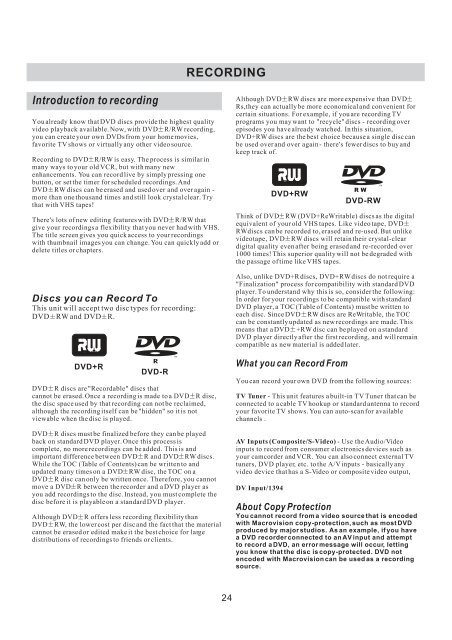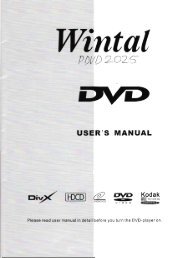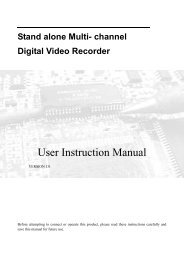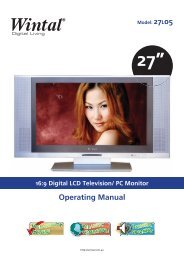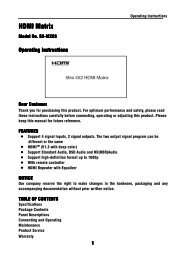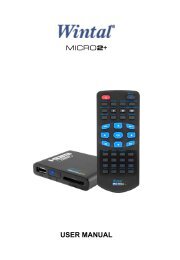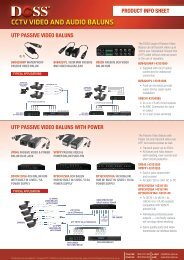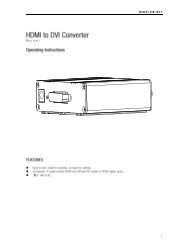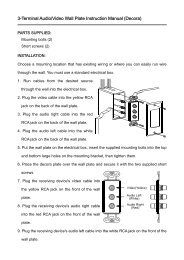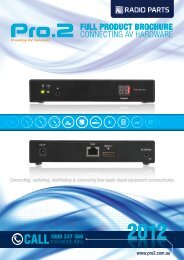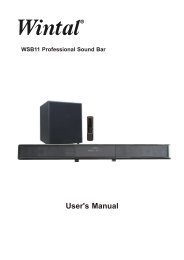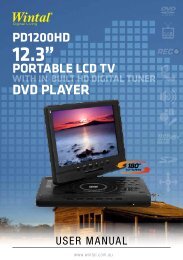You also want an ePaper? Increase the reach of your titles
YUMPU automatically turns print PDFs into web optimized ePapers that Google loves.
Introduction to recording<br />
You already know that DVD discs provide the highest quality<br />
video playback available. Now, with DVD R/RW recording,<br />
you can create your own DVDs from your home movies,<br />
favorite TV shows or virtually any other video source.<br />
Recording to DVD R/RW is easy. The process is similar in<br />
many ways to your old VCR, but with many new<br />
enhancements. You can record live by simply pressing one<br />
button, or set the timer for scheduled recordings. And<br />
DVD RW discs can be erased and used over and over again -<br />
more than one thousand times and still look crystal clear. Try<br />
that with VHS tapes!<br />
There's lots of new editing features with DVD R/RW that<br />
give your recordings a flexibility that you never had with VHS.<br />
The title screen gives you quick access to your recordings<br />
with thumbnail images you can change. You can quickly add or<br />
delete titles or chapters.<br />
Discs you can Record To<br />
This unit will accept two disc types for recording:<br />
DVD RW and DVD R.<br />
DVD+R<br />
DVD-R<br />
DVD R discs are "Recordable" discs that<br />
cannot be erased. Once a recording is made to a DVD R disc,<br />
the disc space used by that recording can not be reclaimed,<br />
although the recording itself can be "hidden" so it is not<br />
viewable when the disc is played.<br />
DVD R discs must be finalized before they can be played<br />
back on standard DVD player. Once this process is<br />
complete, no more recordings can be added. This is and<br />
important difference between DVD R and DVD RW discs.<br />
While the TOC (Table of Contents) can be written to and<br />
updated many times on a DVD RW disc, the TOC on a<br />
DVD R disc can only be written once. Therefore, you cannot<br />
move a DVD R between the recorder and a DVD player as<br />
you add recordings to the disc. Instead, you must complete the<br />
disc before it is playable on a standard DVD player.<br />
Although DVD R offers less recording flexibility than<br />
DVD RW, the lower cost per disc and the fact that the material<br />
cannot be erased or edited make it the best choice for large<br />
distributions of recordings to friends or clients.<br />
RECORDING<br />
24<br />
Although DVD RW discs are more expensive than DVD<br />
Rs,they can actually be more economical and convenient for<br />
certain situations. For example, if you are recording TV<br />
programs you may want to "recycle" discs - recording over<br />
episodes you have already watched. In this situation,<br />
DVD+RW discs are the best choice because a single disc can<br />
be used over and over again - there's fewer discs to buy and<br />
keep track of.<br />
Think of DVD RW (DVD+ReWritable) discs as the digital<br />
equivalent of your old VHS tapes. Like video tape, DVD<br />
RWdiscs can be recorded to, erased and re-used. But unlike<br />
videotape, DVD RW discs will retain their crystal-clear<br />
digital quality even after being erased and re-recorded over<br />
1000 times! This superior quality will not be degraded with<br />
the passage of time like VHS tapes.<br />
Also, unlike DVD+R discs, DVD+RW discs do not require a<br />
"Finalization" process for compatibility with standard DVD<br />
player. To understand why this is so, consider the following:<br />
In order for your recordings to be compatible with standard<br />
DVD player, a TOC (Table of Contents) must be written to<br />
each disc. Since DVD RW discs are ReWritable, the TOC<br />
can be constantly updated as new recordings are made. This<br />
means that a DVD +RW disc can be played on a standard<br />
DVD player directly after the first recording, and will remain<br />
compatible as new material is added later.<br />
What you can Record From<br />
You can record your own DVD from the following sources:<br />
TV Tuner - This unit features a built-in TV Tuner that can be<br />
connected to a cable TV hookup or standard antenna to record<br />
your favorite TV shows. You can auto-scan for available<br />
channels .<br />
AV Inputs (Composite/S-Video) - Use the Audio/Video<br />
inputs to record from consumer electronics devices such as<br />
your camcorder and VCR. You can also connect external TV<br />
tuners, DVD player, etc. to the A/V inputs - basically any<br />
video device that has a S-Video or composite video output,<br />
DV Input/1394<br />
DVD+RW<br />
DVD-RW<br />
About Copy Protection<br />
You cannot record from a video source that is encoded<br />
with Macrovision copy-protection, such as most DVD<br />
produced by major studios. As an example, if you have<br />
a DVD recorder connected to an AV input and attempt<br />
to record a DVD, an error message will occur, letting<br />
you know that the disc is copy-protected. DVD not<br />
encoded with Macrovision can be used as a recording<br />
source.


